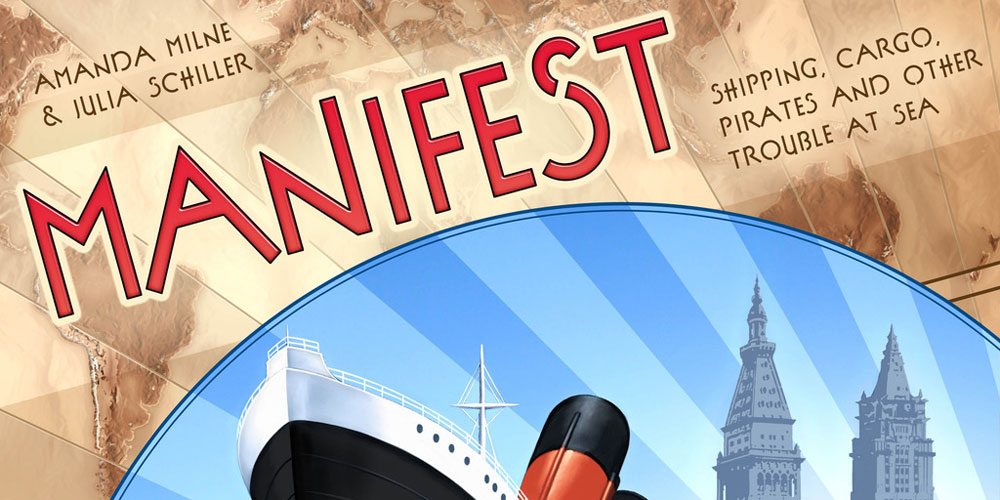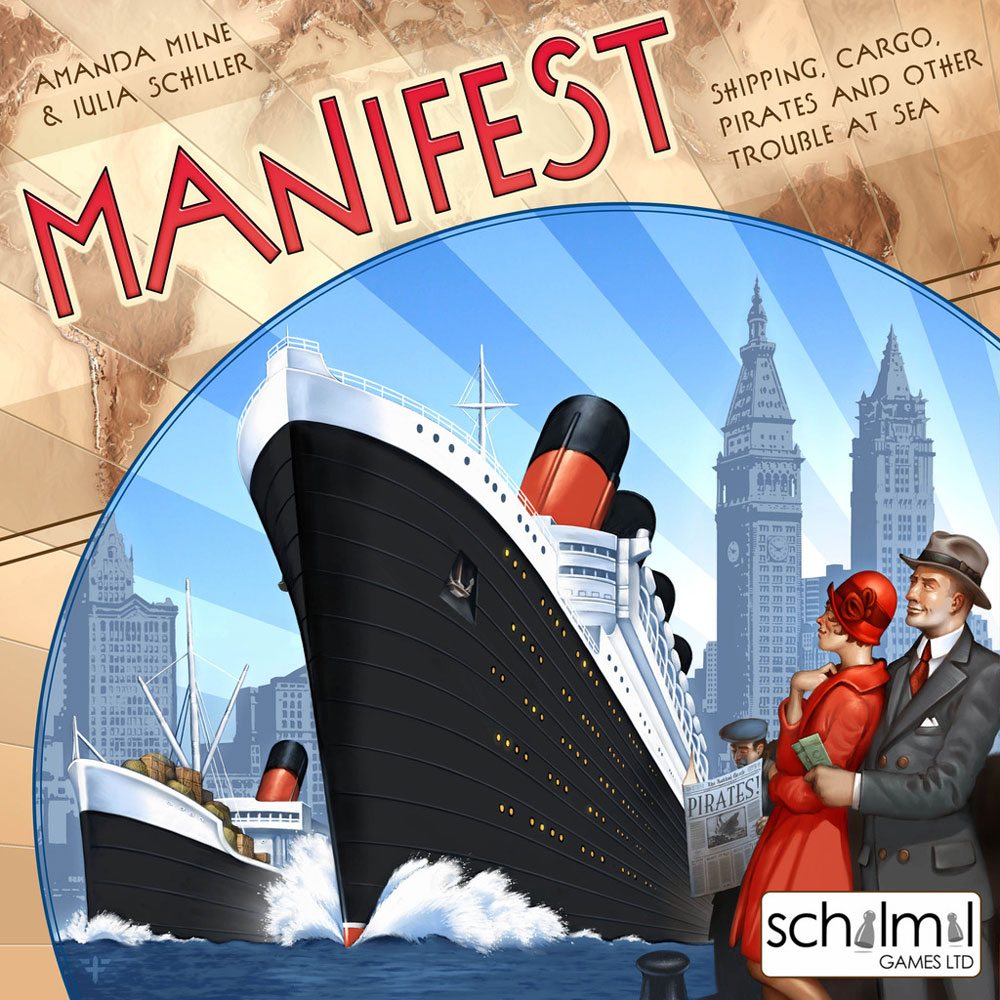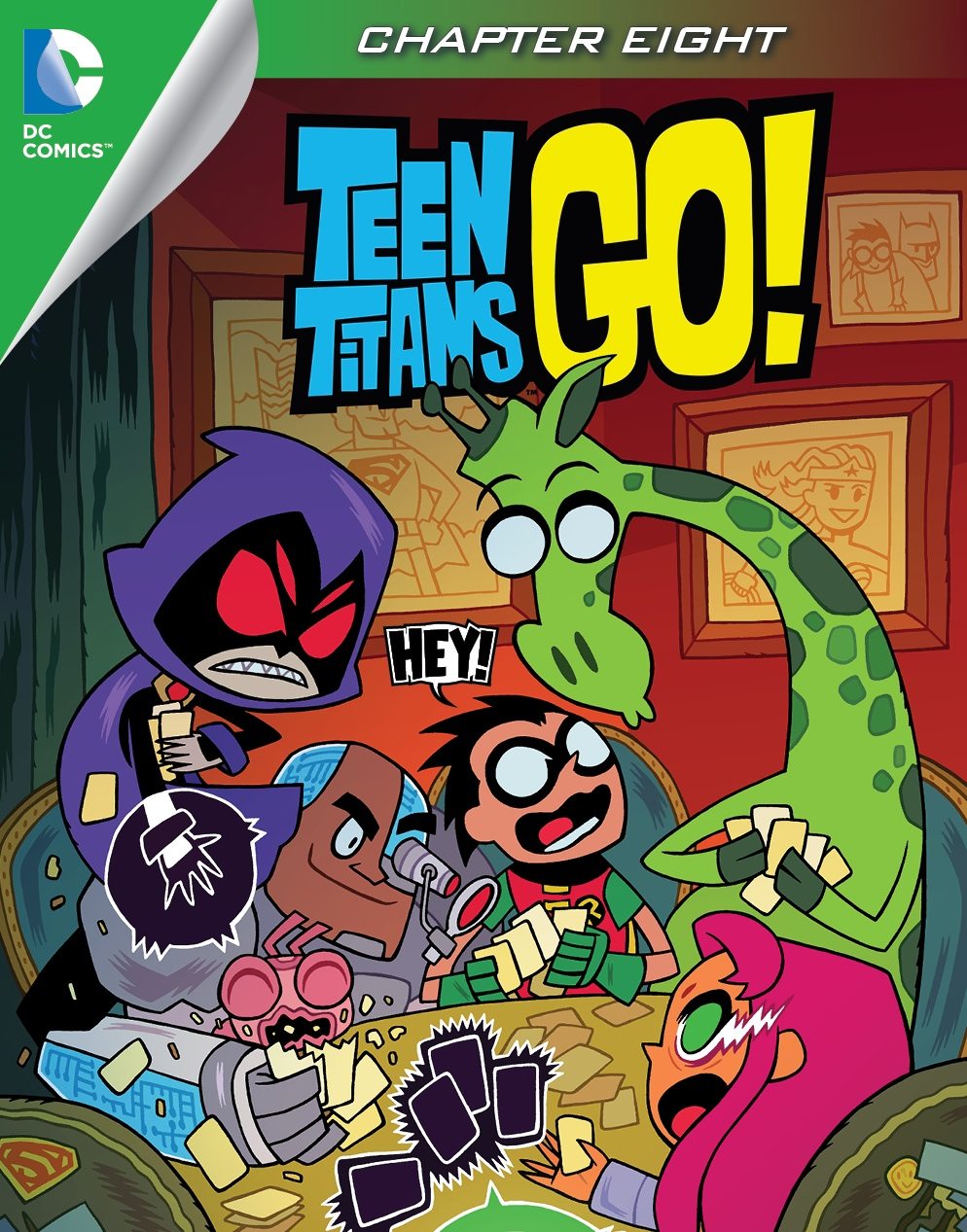Disclosure: GeekDad received a review copy of this game. Making purchases through our affiliate links supports us financially. Thanks!
It’s the 1920s, and shipping goods and passengers around the world is big business–but a dangerous one. In Manifest, you’ll need to find the best contracts, pick up and deliver goods, and (just maybe) engage in a little piracy from time to time.
At a glance: Manifest is for 2 to 5 players, ages 13 and up, and takes 45-90 minutes to play. There are two sets of rules, the basic game and an advanced version that includes a deck-building element; I think the basic game could be taught to players as young as 8 or 9, and the advanced game will be fairly easy to pick up for those who are already familiar with deck-building games. Manifest retails for $55, though if you order directly from Schilmil Games by December 31, you can get 20% off your entire order using the coupon code KICKED2014. (Be sure to check the currency displayed and shipping options carefully, since Schilmil is based in New Zealand.)

Components:
- 1 double-sided game board
- 10 Cargo ships in different colors
- 1 Pirate ship
- 5 Company Advantage cards
- 54 Action cards
- 60 Starter & Upgrade cards (12 each in 5 colors)
- 28 Deck-builder Action cards
- 42 Contract cards
- 48 Cargo tokens (6 each in 8 colors)
- 24 Passenger meeples (6 each in 4 colors)
- 2 custom six-sided dice
- 5 Shipping Company boards
- 5 player aid cards
Some of the components are used only for the advanced rules, and some are used for variant rules.
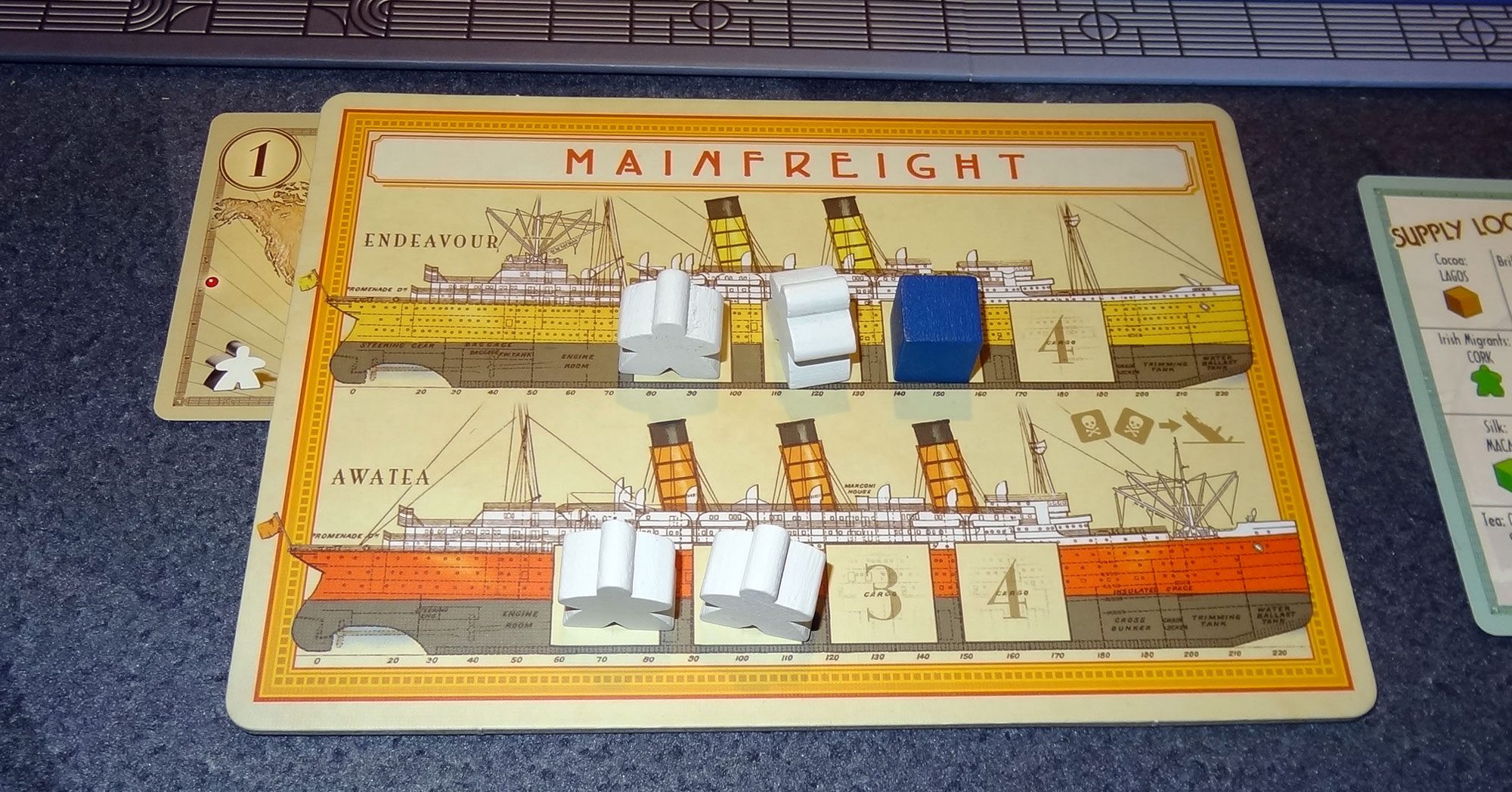
The Shipping Company boards are nicely done–again slightly larger than is absolutely necessary, but fine. Each one has the name of a shipping company, and lovely illustrations of two ships (with names), each with 4 cargo spaces. The ships on each board are two different colors, corresponding to the wooden ship tokens, so you can tell your two ships apart. (Note: I’m not sure if these are color-blind-friendly, and there’s no other way to distinguish the ship tokens.)
The board is a map of the world with various routes and port locations marked; red paths mean that there’s a risk of pirates. The map is double-sided so that you can decide whether you want the Atlantic or Pacific centered, but is otherwise identical. There are spaces for three open contract cards and the deck, and locations for the Action draw pile and discard pile. One thing they could have taken advantage of in the double-sided board is adding more spaces on the board for the advanced game, which should have three more spaces for cards.
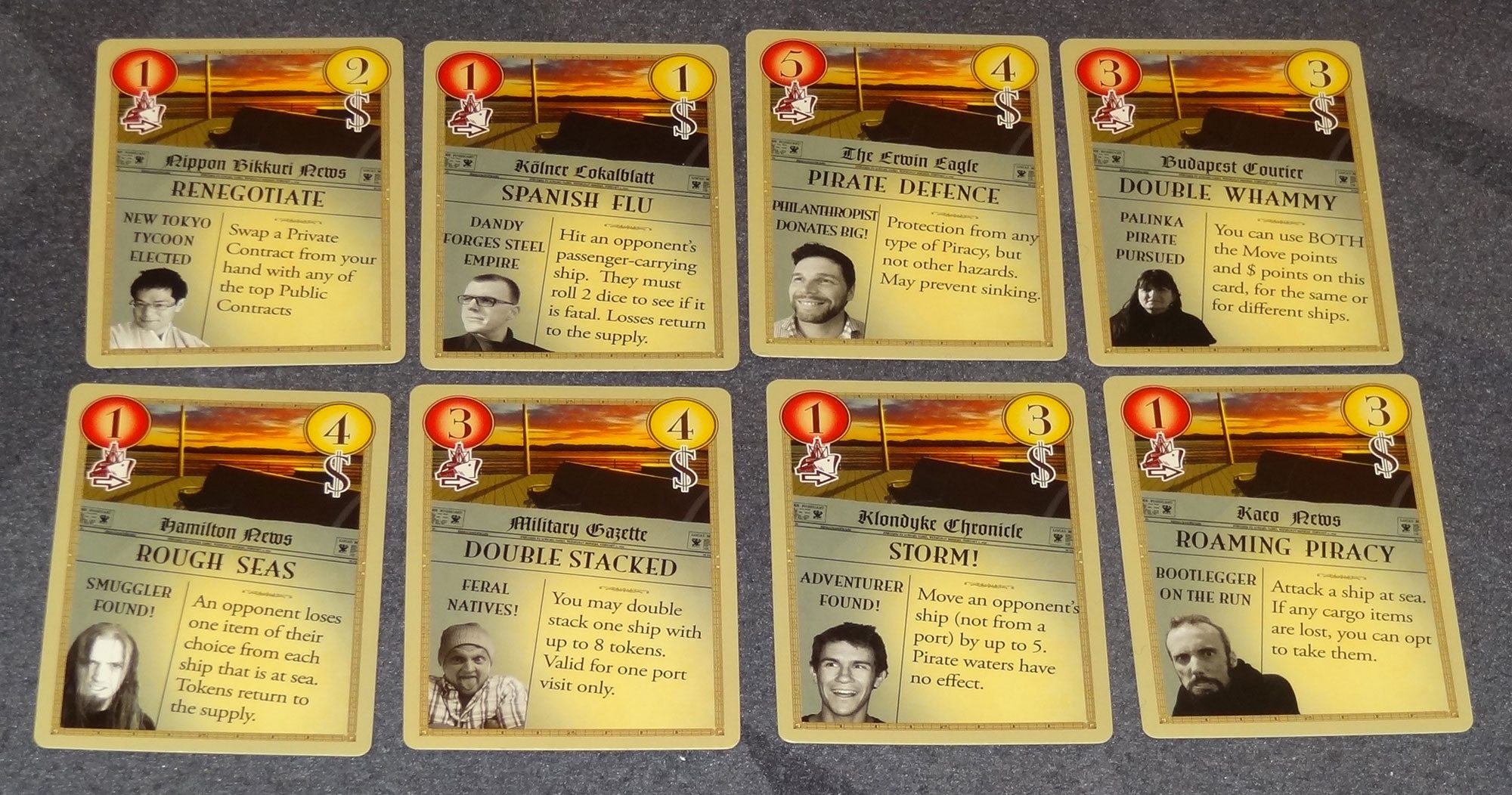
Each Action card has a section made to look like a newspaper, with a title (indicating the type of action), a description of the card’s effect, and then a small photo with a headline. These are all photos of Kickstarter backers, and it’s pretty amusing to see the headlines and photos, though these don’t affect gameplay.
The wood components are pretty nice: the wooden ships and cargo cubes are a pretty nice size, and the board is large, so everything feels pretty substantial. The one thing that is slightly confusing about the wooden bits is that some of the cargo cubes and passenger meeples are the same color–for instance, the Japanese meeples and sugar cubes are all white, even though they’re not actually related to each other. It might have been nice to use unique colors, though then they would have needed 12 different colors instead of 8.
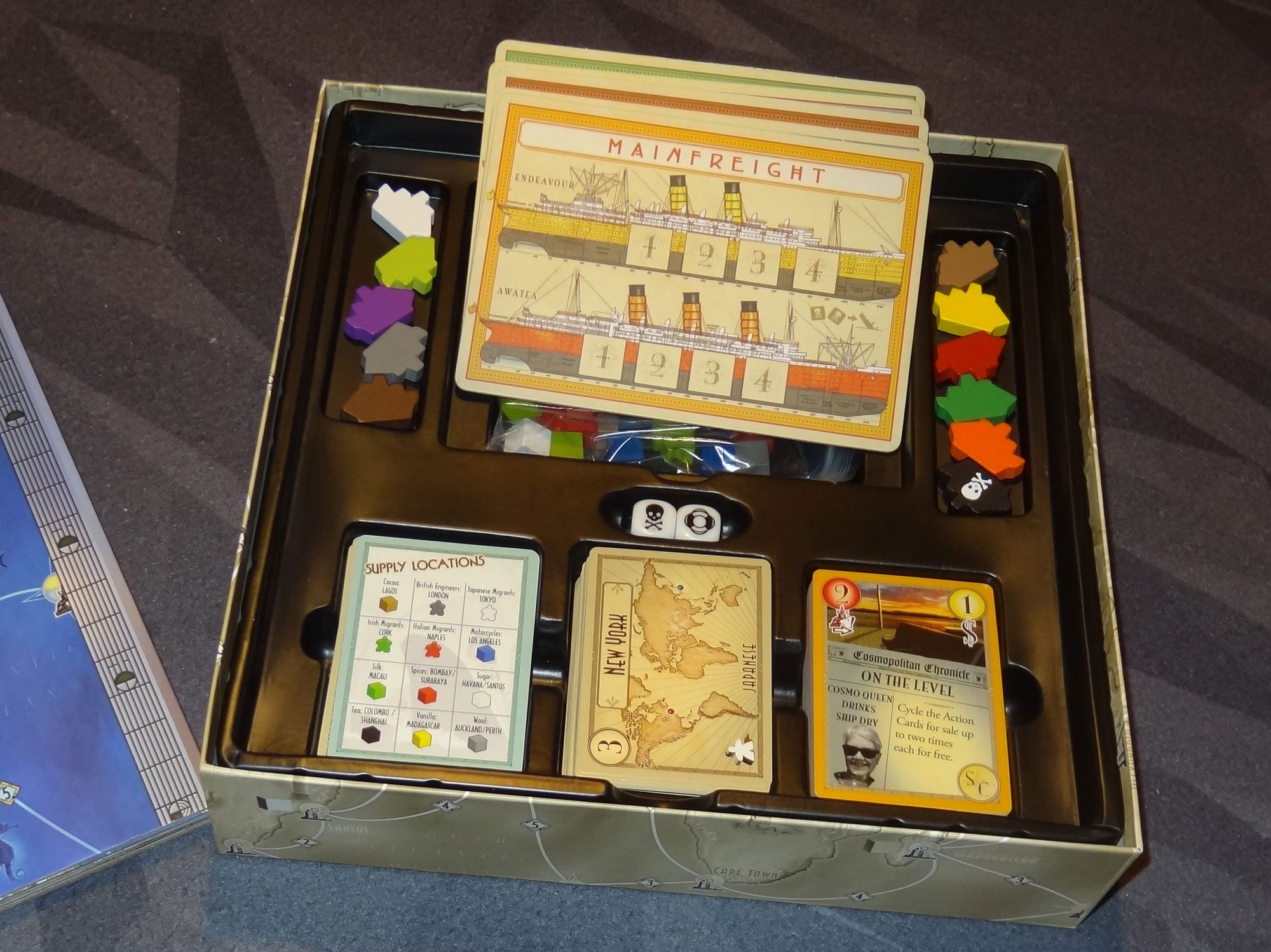
The plastic insert is (hooray!) well-designed, with room for everything, and the box size matches the components pretty well.
How to play
You can download a copy of the rules here, or visit the Schilmil website for how-to-play videos.
The goal of the game is to be the first to reach the target number of points, which varies according to player count and desired game length. You earn points by fulfilling shipping contracts, successfully delivering goods and passengers to the desired locations.
Each player gets a shipping company board and the two corresponding ships, three contract cards, and four action cards. The rest of the action cards form a draw pile, and the contracts form a separate draw pile. Each player chooses two contracts to keep–the rest are placed face-up in the open contracts section of the board. (Only three open contracts are visible and available at a time.) Players take turns placing their ships onto the board in any location. In the basic game, the deck-building action cards are not used.
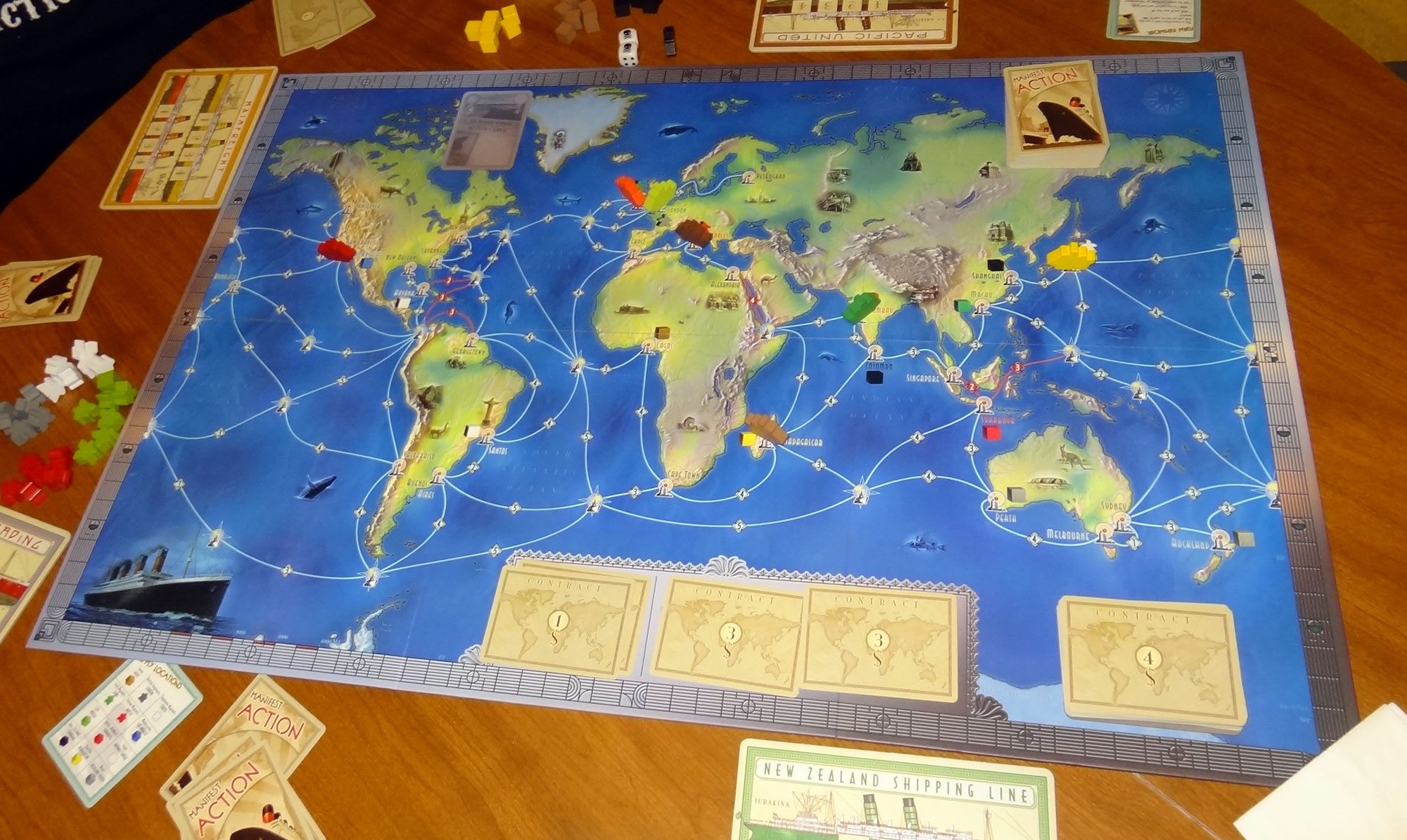
On your turn, you get to play as many action cards as you like, and then draw back up to four cards at the end of your turn.
Each card has three uses, and you’ll have to decide which of the three to use when you play the card. You can use the card for movement, money, or the card effect.
To move your ships, you must pay the movement cost shown on the board, using any number of cards. If you move across red routes, you’ll need to roll dice to see if you get attacked by pirates. The dice indicate which of your cargo holds are attacked. Two skulls means your ship is sunk–you lose all of your cargo, and you’ll launch a new ship from any port next turn. (The lifesaver icon is just a safe side of the die and doesn’t affect you.)
When you’re in a port that supplies goods or passengers (as marked on the board), you may load those onto your ship by paying $1 per item. Each cargo hold can hold one item unless you have a Double-Stacking ability. Loading extra goods of the same type can help you survive pirate attacks.
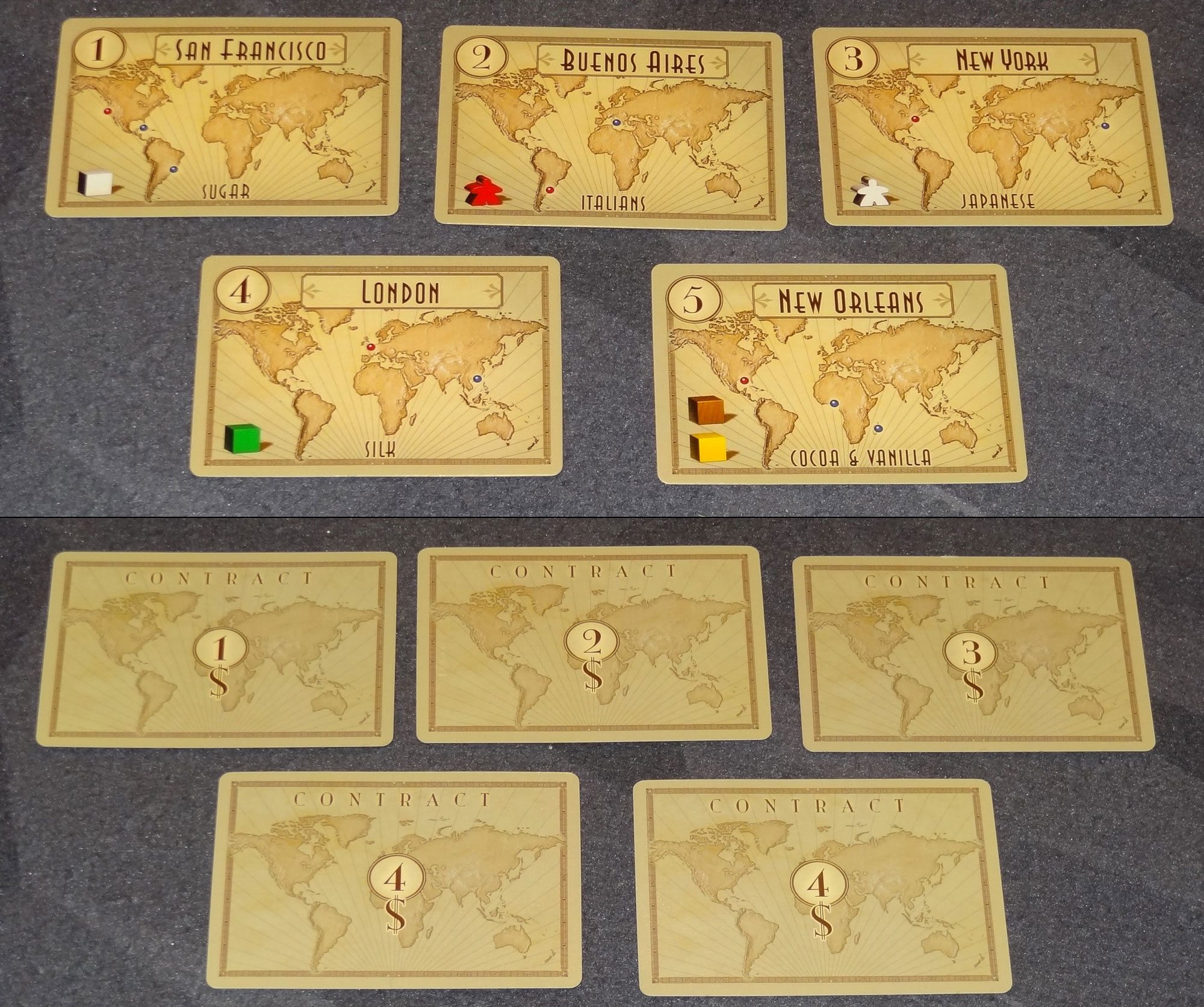
You may also use money toward purchasing new contracts by buying them from the deck, but you may only have up to three in your hand. The back of each card shows how much it costs, between $1 and $4, which also corresponds to the point value (though there are some $4 contracts that are worth 5 points).
If you’re in a port that wants goods or passengers for a contract, whether that’s an open contract on the board or a private contract in your hand, you may offload any number of that cargo to fulfill that contract. Extra goods offloaded don’t give you more points; however, if you need to make space in your cargo holds later on, it costs you $1 per item to remove it. Fulfilled contracts go next to your player board so you can see how many points you have. Any open spaces in the open contracts section are refilled.
Finally, the cards have various effects: they let you attack other players at port or at sea, swap cargo on your ship for something else, get new contracts, and more.
As soon as a player has hit the target score, all the other players get one more turn, and then the game ends. Highest score wins, with ties going to the player with the most cargo left in their holds.
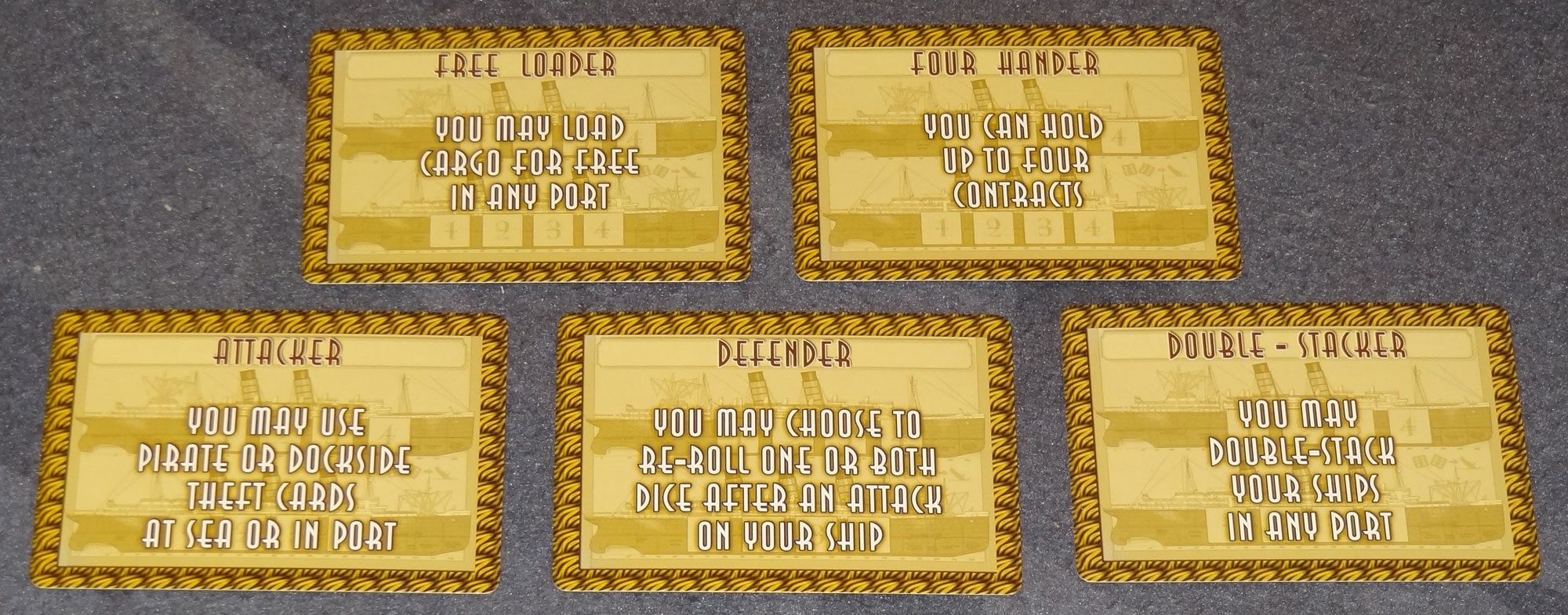
There are two small variants that can be added separately or together. In the first, you deal out a Company Advantage card to each player–these give you a bonus, like Double-Stacking, loading cargo for free, and so on. There are Action cards that let you trade or rotate these advantage cards. The second variant uses the pirate ship token: whoever loses cargo to a pirate takes the ship; if you have the ship, you may steal the cargo that was lost (swapping from your cargo hold if desired).
The expert game introduces deck-building, but uses primarily the same rules. Instead of the regular action cards, you shuffle the Deck-building Action cards and form a deck of those, with three turned face-up next to the deck. Each player gets a set of cards matching their company board–half are starting cards (marked with S) and half are upgraded cards (marked with U). You start with the six starting cards in your own personal deck.
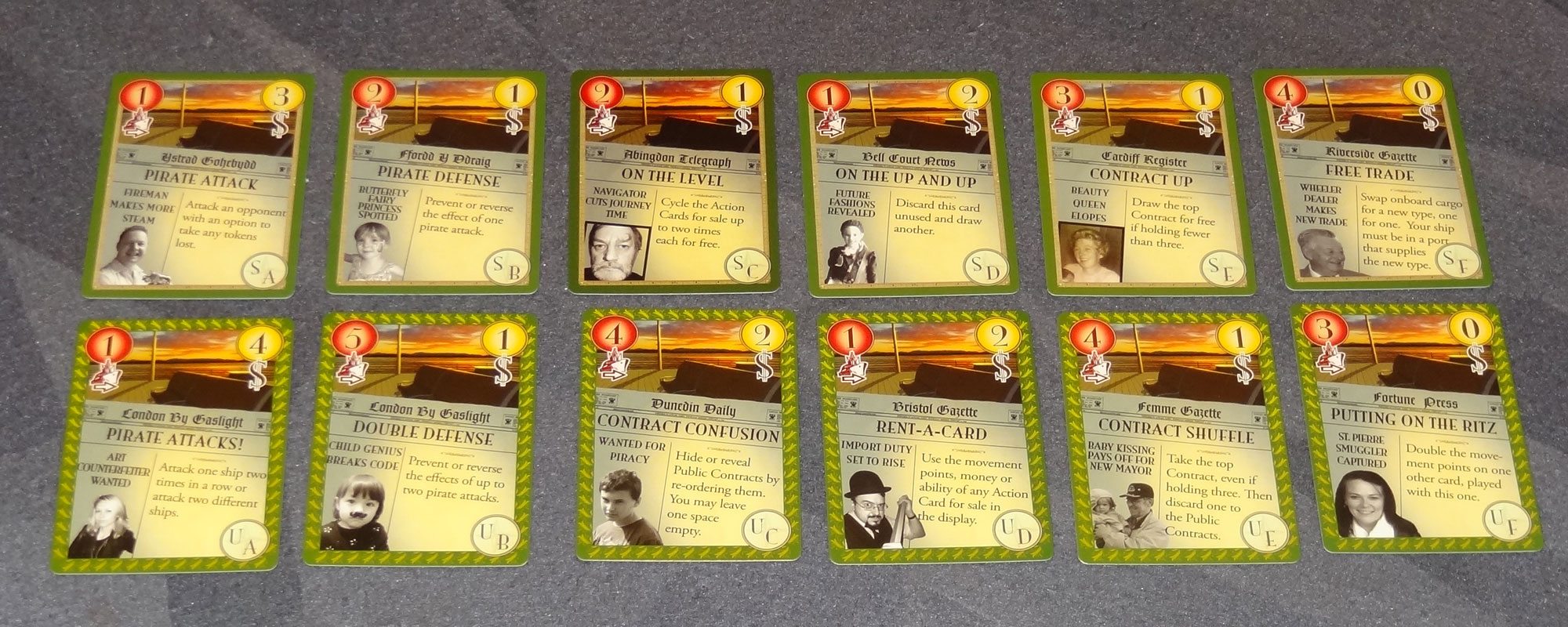
You manage your own draw pile and discard pile, and now your hand size is only 3. Whenever you run out your draw pile, you shuffle your discard pile. On your turn, you may now also use money to purchase any of the three face-up cards for $3 each, replacing them from the draw deck. Purchased cards go into your discard pile. You may also spend $1 to cycle the action cards–that is, discard any number of them and replace them from the draw pile.
You may also spend $5 to upgrade a starting card in your hand. Each card is also labeled with a letter A through F; if you upgrade a starting card, you remove it from your deck and put it back in the game box, and put the corresponding upgraded card into your discard pile.

There are a few new card effects introduced in the expert game, but otherwise gameplay is mostly the same.
The Verdict
Manifest was funded through a Kickstarter campaign earlier this year, and was officially released in August. The publisher, Schilmil games, was founded in 2011 by two women from New Zealand, Amanda Milne and Julia Schiller. (According to their website, Schiller left this year to start a new business.) Manifest is their fifth game design, but the first one funded through Kickstarter. I had been noticing recently that I have very few games in my collection that were designed by women, so I was intrigued–plus I don’t know that I have many games from New Zealanders, either.
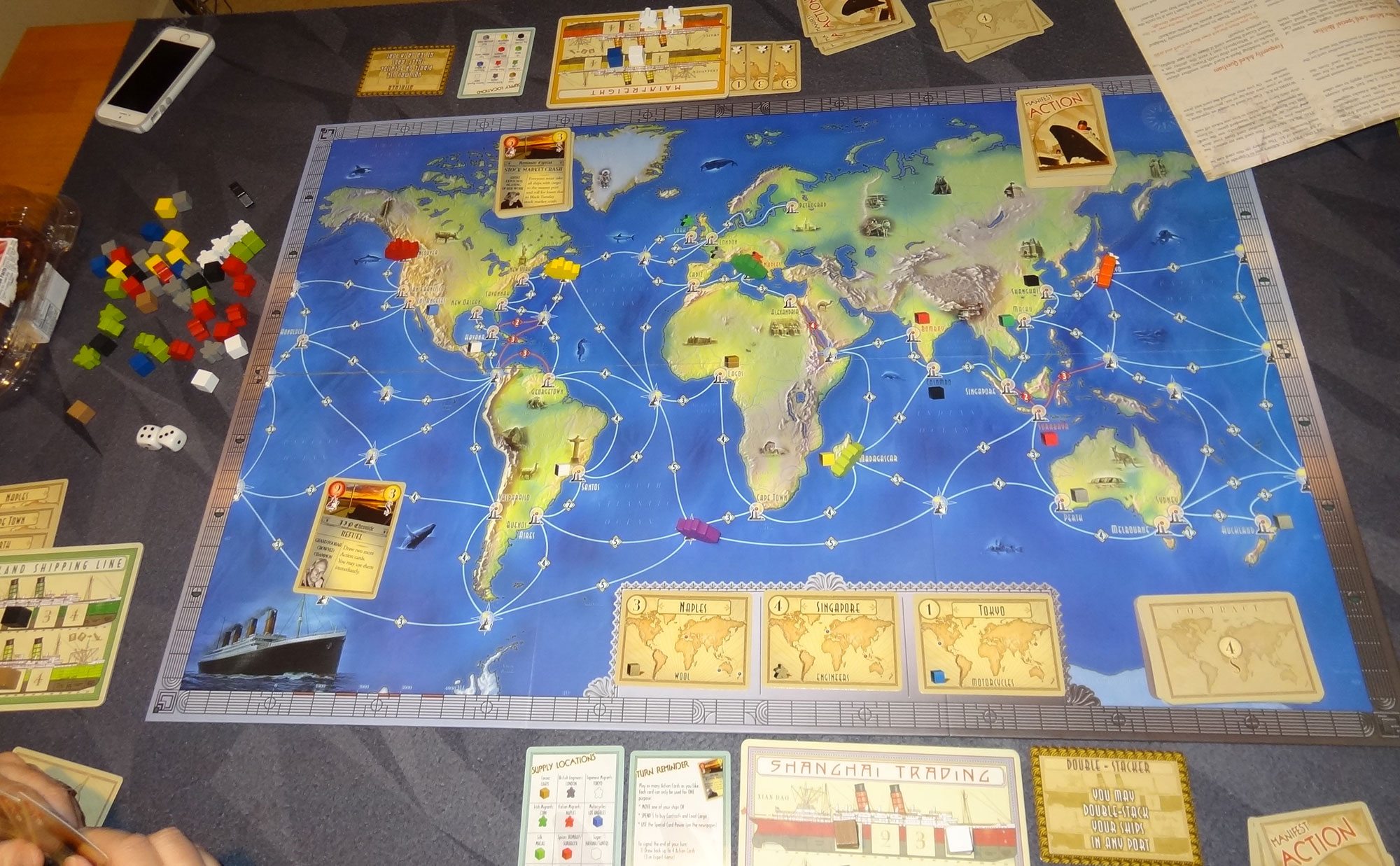
Manifest is a pick-up-and-deliver game: get to the stuff, pick it up, get to the goal, drop it off, score points. In the basic game, primarily you’re deciding how quickly to move each turn–do you move the ship that already has cargo, or do you move your other ship to go pick up cargo for another contract? There can be some racing to fulfill open contracts first, but otherwise you could all just mind your own business, moving things along.
A lot of the cards have a “take that” feel to them–you can get a chance at stealing cargo from another player, which is particularly handy if they’ve picked up something far away and you’re near the delivery site. But if your gaming group is a friendly one, you might find that players are more interested in using the card for movement points instead of their effects. The world is a big place, and with only four cards, it can take you several turns just to sail from the source of your cargo to the destination, never mind piracy and storms and other hazards.
The deck-building in the expert game adds some more depth to it, and I think experienced players will want to move to this version quickly. It gives you more control over the cards you’re drawing. If you want a slim deck so you can predict what’s coming next, you can upgrade your cards and avoid purchasing a lot of new cards. Or, you can spend your money looking for powerful cards, depending on whether you want movement, money, or card effects.

One thing I thought was somewhat odd, though, is that the cards don’t feel balanced at all. Some cards have high movement and money, and some are low in both. And it’s not tied to the card effect, either–in fact, there are multiple cards with the same effect that have different movement and money values, so in those cases one card is definitively better than the other. That’s the part of the basic game that I didn’t care for, because it means that more of your success depends on whether you get a good hand or a bad hand from the deck. The deck-building mitigates the luck factor a little because you have more control over what goes into your deck. If you don’t buy any weak cards, you won’t draw them.
The pirate variant is pretty good, but I didn’t care for the Company Advantage variant as much. Some of the advantages are definitely better than others–which also means they’ll change hands more frequently, if you want to spend the cards to do so.
Overall, I thought Manifest was pretty fun, even if it didn’t feel like it was a wildly innovative concept. It’s a nice pick-up-and-deliver game, and I like that it incorporates the deck-building aspect (because I’m a fan of deck-building games). It’s easy to tailor the length of the game by setting the target score, and the game can be as nice or as mean as the players want to be.
For more about Manifest, visit Schilmil Games. You can pick up a copy at your local game store, from Amazon, or directly from Schilmil Games.
